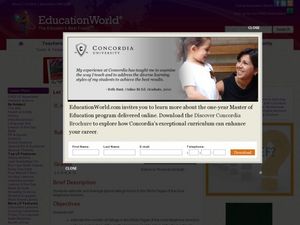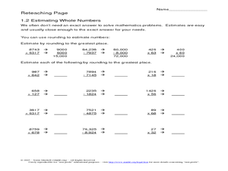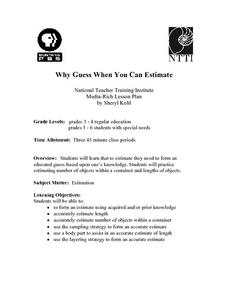Curated OER
Estimating Solutions to Word Problems
Learners use estimation to determine the answers to word problems by rounding whole numbers. In this estimation lesson plan, pupils compare and contrast solutions using the best answer.
Curated OER
Let Your Fingers Do the Estimating
Investigate estimation with the White Pages. Youngsters use the phonebook to estimate the average number of phone listings that can be found there. They write a paragraph explaining the processes they used in this challenge.
EngageNY
Margin of Error When Estimating a Population Mean (part 1)
We know that sample data varies — it's time to quantify that variability! After calculating a sample mean, pupils calculate the margin of error. They repeat the process with a greater number of sample means and compare the results.
EngageNY
Estimating a Population Proportion
Find the percent of middle schoolers who want the ability to freeze time. The 21st installment in a series of 25 has groups collect a random sample of respondents who answer a question about superpowers. Using sample statistics,...
EngageNY
Margin of Error When Estimating a Population Proportion (part 1)
Use the power of mathematics to find the number of red chips in a bag — it's a little like magic! The activity asks learners to collect data to determine the percentage of red chips in a bag. They calculate the margin of error and...
EngageNY
Margin of Error When Estimating a Population Mean (part 2)
Don't leave your classes vulnerable in their calculations! Help them understand the importance of calculating a margin of error to represent the variability in their sample mean.
EngageNY
Margin of Error When Estimating a Population Proportion (part 2)
Error does not mean something went wrong! Learners complete a problem from beginning to end using concepts developed throughout the last five lessons. They begin with a set of data, determine a population proportion, analyze their result...
Curated OER
Estimating Whole Numbers
Learners solve problems by rounding two to five-digit numbers to the nearest greatest place number. They complete 12 problems.
Curated OER
Estimating the Mean State Area
Seventh grade statisticians randomly select five states and then determine the mean area. The class then works together to create a dot plot of their results.
Mathematics Assessment Project
Estimating Volume: The Money Munchers
Don't stuff money under your mattress. To find out why learners first complete a task determining how $24,000 in cash would affect the height of a mattress and whether this same amount would fit into a suitcase of given dimensions. They...
EngageNY
Estimating Centers and Interpreting the Mean as a Balance Point
How do you balance a set of data? Using a ruler and some coins, learners determine whether the balance point is always in the middle. Through class and small group discussions, they find that the mean is the the best estimate of the...
Utah State University
Estimate Study Hours
How many hours should learners devote to studying outside of class? Learners use this worksheet to not only practice estimation, but also develop a valuable study skill for their future academic careers.
EngageNY
The Difference Between Theoretical Probabilities and Estimated Probabilities
Flip a coin to determine whether the probability of heads is one-half. Pupils use simulated data to find the experimental probability of flipping a coin. Participants compare the long run relative frequency with the known theoretical...
Curated OER
Estimate Products
In this estimating products instructional activity, students interpret data on the yearly diets of the average American, then solve 6 word problems where they must estimate products by rounding the larger factor to its greatest place value.
Curated OER
Reasonable Estimates
Help pupils explore estimation. They will make estimates and discuss when you might use an estimate. Then they discuss if their estimates are reasonable.
Curated OER
Go Fish
Help learners discover methods to estimate animal population. They will participate in a simulation of catching and tagging fish in order to estimate the fish population. They scoop and count goldfish crackers, record data, and use...
Curated OER
Estimating Products
Multiplication on the fly becomes easy with the magic of estimating! Scholars round numbers up to four digits to complete multiplication problems without a calculator. They write in the new factors and the approximate product for the...
Google
Surveys and Estimating Large Quantities
Looking for an estimation activity a bit more involved than the typical "guess the number of jellybeans in the jar" game? Here, learners use a picture to estimate the number of people at a large event, look for potential problems with...
Curated OER
Estimate Length
Without measuring, can estimators determine which string is the longest? The shortest? There are two sets of strings here for learners to evaluate, circling the shortest in the first set and the longest in the second. Next, they eyeball...
CK-12 Foundation
Square Roots and Irrational Numbers: Estimating Radicals
Try out a resource using triangles to estimate radicals. An interactive app allows learners to approximate some irrational numbers involving square roots. They find the two consecutive numbers that an irrational number lies between by...
Curated OER
Everyday Mathematics: Rounding
In this rounding practice worksheet, students sharpen their math skills as read tips pertaining to rounding numbers and try the extra practice activities.
Curated OER
Estimating School Store Purchases
Students examine uses for estimating, and round purchase prices to estimate total purchases in a simulated school store setting. They discuss what it means for an item to be on sale, and observe the teacher work through the process of...
Curated OER
Why Guess When You Can Estimate
They apply various strategies in their estimations. They analyze the differences between guessing and estimating. They estimate the number of beans and jellybeans in egg cartons and jars respectively.
Curated OER
Mystery Jars
Youngsters discover ways to estimate. They will use two jars with large and small items and estimate the number of items. Then record their estimate and explain why they answered the way they did. They try this experiment with different...

























